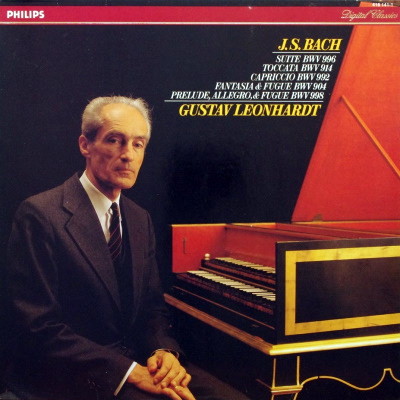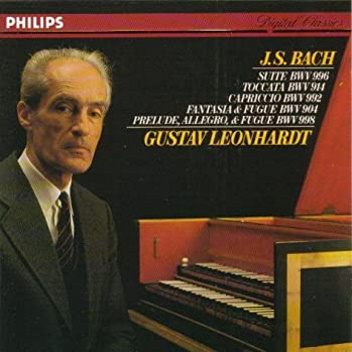 |
|
1 LP -
416 141-1 - (p) 1985
|
 |
| 1 CD -
416 141-2 - (p) 1985 |
|
BACH RECITAL
|
|
|
|
|
|
|
|
| Johann Sebastian
BACH (1685-1750) |
Suite
in E minor, BWV 996
|
|
14' 16" |
|
|
-
Praeludio. Presto
|
2' 10" |
|
1
|
|
-
Allemande |
3' 20" |
|
2
|
|
-
Courante |
2' 23" |
|
3
|
|
-
Sarabande
|
2' 59" |
|
4
|
|
-
Bourrée |
0' 57" |
|
5
|
|
-
Gigue |
2' 27" |
|
6
|
|
Fantasia
and Fugue in A minor, BWV 904 |
|
7' 22" |
|
|
-
Allegro -
|
2' 47" |
|
7
|
|
-
Fuga (Allegro moderato)
|
4' 35" |
|
8
|
|
Toccata in E
minor, BWV 914 |
|
7' 02" |
|
|
-
(-) Un poco allegro
|
2' 06" |
|
9
|
|
-
Adagio |
1' 55" |
|
10
|
|
-
Fuga (Allegro)
|
3' 01" |
|
11
|
|
Capriccio
in B flat, BWV 992 - "sopra la
lontananza del suo fratello
dilettissimo"
|
|
12' 33" |
|
|
-
1. Arioso (Allegro)
|
2' 25" |
|
12 |
|
-
2. (-)
|
1' 56" |
|
13 |
|
-
3. Adagissimo
|
2' 53" |
|
14 |
|
-
4. (-)
|
1' 00" |
|
15 |
|
-
5. Aria di postiglione (Allegro
poco)
|
1' 52" |
|
16 |
|
-
6. Fuga all'imitazione della
cornetta di postiglione
|
2' 27" |
|
17 |
|
Prelude,
Fugue and Allegro in E flat,
BWV 998 |
|
11' 52" |
|
|
-
Prélude |
3' 12" |
|
18 |
|
-
Fuga |
5' 45" |
|
19 |
|
-
Allegro |
2' 55" |
|
20 |
|
|
|
|
|
Gustav Leonhardt,
Harpsichord (William Dowd, Paris, 1984,
fter M. Mietke (?), c.1715. Berlin) - a' =
415 Hertz
|
|
|
|
|
|
Luogo
e data di registrazione |
|
Haarlem (The
Netherlands) - Dicembre 1984
|
|
|
Registrazione: live
/ studio |
|
studio |
|
|
Recording
Supervision |
|
-
|
|
|
Engineer |
|
-
|
|
|
Prima Edizione LP |
|
Philips | LC 0305 |
416 141-1 | 1 LP - durata 54' 31"
| (p) 1985 | DDD
|
|
|
Edizione CD |
|
Philips | LC 0305 |
416 141-2 | 1 CD - durata 54'
31" | (p) 1985 | DDD |
|
|
Cover Art
|
|
-
|
|
|
Note |
|
-
|
|
|
|
|
If one
arranges the works played on
this recording in a roughly
chronological order, the
"Capriccio on the Departure
of a Beloved Brother", BWV
992, is verifiahly the
earliest. Bach wrote the
six-movement piece in
Arnstadt in 1704 when his
brother, Johann Jacob, was
preparing so travel in
Sweden to join king Karl
XII's Guards as an oboist.
Clearly influenced, to some
extest, by the programmatic
"Biblical" Sonatas of Johann
Kuhnau, which had been
published four years
earlier, the young Bach
devised a series of genre
pieces of amazing vividness,
to which he gave descriptive
titles. In the first,
friends plead with the
aspiring traveller in smooth
consecutive sixths, trying
to whendly him into giving
up the journey. In the
second, they point out, in
sorrowfully falling a
modulations, the many perils
he may encounter in a
foreign land. In the third,
they raise a general Lamento
with many sighing motives.
The fourth piece is devoted
fo the departure; everyone
seems to be treading on
everyone else's heels as
chords and entries pile up
after each other. The aria
of the postillon, with a
realistc crack of the whip,
in followed finally by a
lively, swinging fugue on
the posthorn fanfare,
accompanied by two obbligato
contrapostal parts.
The E minor Toccata, BWV
914, was written around
1710, during Bach's "Sturm
und Drang" period - the
"storm and stress" years of
duty in Weimar. The
impetuous, sometimes free
and rhapsodical form has the
air of a long-breathed
improvisation. As in all
keyboard toccatas, Bach
begins with solo runs and
ends with a bread fugue.
Opening and close are linked
by a figure which descends
diatonically within the
compass of a fith. This also
anticipates the cerebral,
contemplative double fugato.
An Adagio follows,
in which it becomes clear
that Bach is aisning at
motivistic relationship and
inser connextion of the
movements within the work.
Probably around 1720, Bach
came into close contact with
the Dresden court lutenist,
Silvius Leopold Weiss. It is
clear that we owe to his
encouragement a series of
lute compositions, among
them the Suite in E minor,
BWV 996 and the Prelude,
Allegro, and Fugue in E
flat, BWV 998. Since
compositions for the lute
and for the clavier had for
many years been
interchangeable, these
pieces were equally suited
to interpretation on the
harpsichord. In the E minor
Suite, the five stylised
dances (Allemande, Courante,
Sarabande, Bourrée, and
virtuosically fugal Gigue)
are preceded by a highly
original prelude - a free,
harmonically piquant,
toccata-like opening, headed
Passaggio, followed
by a strict, fugal Presto.
The hand of the mature
mastree is again evident in
the three movement E flat
major work, which Bach seems
to have conceived originally
for harpsichord. The prelude
has much in common with the
opening movements of the
"French" Suites. The sizable
da capo fugue - a
rarity from Bach - has a
playful middle section,
dominated by a fresh,
repeatedly extended motive.
The work, which is
intensified from one
movement to the next,
culminates in a precipitate,
richly figured Allegro.
The Fantasy and Fugue in A
minor, BWV 904 may have been
written in Cöthen, or
perhaps later, in Leipzig.
It is a clavier work which
closely approaches the
mature organ style. The
Fantasy is constructed in
concertante style as a
ritornello piece, with clear
distinctions between tutti
and solo sections. The
double fugue is of
convincing claruty and
balance. Bach develops Theme
I in the forst part: in the
second he immediately
introduces Theme II (in the
form of the rhetorical
figure of the passus
duriusculus, the
chromatically descending
fourth) and then combines
both themes in a stretto
towards the end. The whole
fugue, including the
episodes, grows exclusively
from the thematic material
is a model of the utmost
concentration and
spiritualisation of music.
Lothar
Hoffmann-Erbrecht
Translation:
Miriam Verhey-Lewis
|
  |
|
|